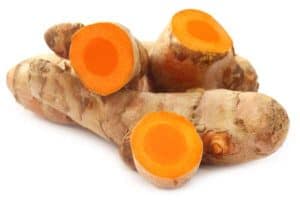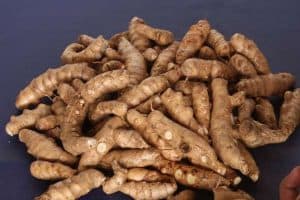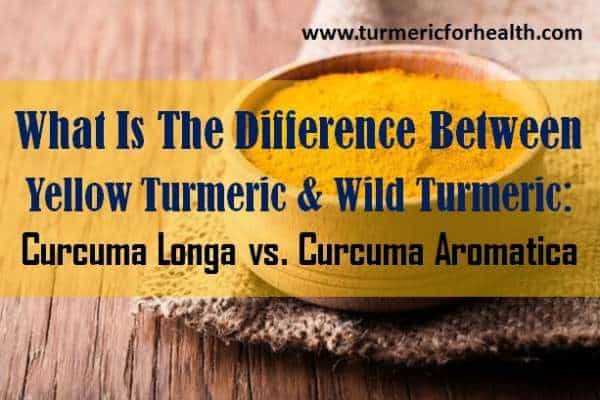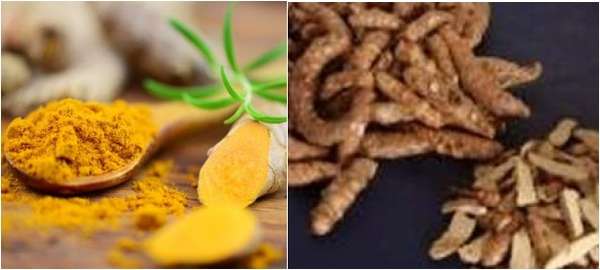It is a well known fact that turmeric is a spice used in the Asian countries. Apart from that, this plant has a long history of medicinal use.
The use of turmeric dates back to 4000 years ago during the Vedic culture.
Till date most, or rather in all articles hosted on the portal, when we say turmeric we mean Curcuma longa. Indeed turmeric is a product of a rhizome called Curcuma longa. This plant belongs to the Zingiberaceae or ginger family.
There are 133 or more species under the genus Curcuma and Curcuma longa is one such species. C. aromatica, C.caesia, C. zedoaria, C. comosa are few of the other important species.
This article covers features of two different species C. longa and C.aromatica as well as their pharmacological value.
Please feel free to use the Table of Contents below to jump to the relevant section in the article.
Table of Contents
What is Curcuma longa or Yellow Turmeric?
Curcuma longa, as I mentioned previously, is the commonly used turmeric and is highly researched upon. India produces maximum of the world’s turmeric crop and consumes 80% of it.
Turmeric powder is prepared from the rhizome which is dull yellowish in color and orange on the inside.
Composition of Yellow turmeric
The pharmacological properties are attributed to a number of chemical components present in turmeric.
Over 100 components have been isolated from turmeric. There are two phases of these components:
- Curcuminoids
- Turmeric oil

There are three curcuminoids: curcumin, demethoxycurcumin, and bisdemethoxycurcumin.
Curcumin is the active component of turmeric and its biological activities have been highly researched upon.
The prime function of the curcuminoids is to serve as antioxidants and to impart yellow-orange color to the herb.
Most turmeric species have 4-6% of curcuminoids as per dry weight. Curcumin alone constitutes 2-5% of the rhizome content.
The oil fraction consists of a number of aromatic (carbon ring structure) compounds:
- d-α-phellandrene, d-sabinene, cinol, borneol, zingiberene
- sesquiterpenes, like germacrone; termerone; ar-(+)-, α-, and β-termerones; β-bisabolene; α-curcumene; zingiberene; β-sesquiphellanderene; bisacurone; curcumenone
The compounds in turmeric oil that are responsible for its aroma are turmerone, arturmerone, and zingiberene.
Turmeric oleoresin is obtained by organic solvent extraction of cured Curcuma rhizomes followed by evaporation. It consists mainly of the volatile oils and also a certain extent of curcuminoids.
Apart from bioactive molecules, the rhizome contains 70% carbohydrates, 7% protein, 4% minerals, at least 4% essential oils, vitamins, and about 1% resin.
What are the health benefits of Curcuma longa (Yellow turmeric)?
Ayurveda or traditional Indian medicine system calls turmeric ‘The Golden Spice’. Recent scientific evidence also proves that turmeric and especially curcumin proves to be therapeutic in a number of diseases and conditions.
1. Turmeric reduces inflammation
Turmeric is a potent anti-inflammatory agent. It acts against the inflammatory chemicals and also reduces the activity of proteins that influence the inflammatory process.
Read: Turmeric for Inflammation
Turmeric works well for arthritis. A clinical trial demonstrated that curcumin exhibits identical anti-arthritic potential as phenylbutazone, a commonly prescribed drug for arthritis.
Another study proved that Meriva, a special formulation of curcumin, is effective as a complementary therapy for osteoarthritis.
Uveitis is the inflammation of the middle layer of the eye. Curcumin is proven to be effective and better than steroids in treating this condition as well as preventing its recurrence. Turmeric helps in reducing postoperative inflammation and fever.
What does this mean?
Turmeric and mainly curcumin exhibit anti-inflammatory property which is the reason why it serves to be therapeutic in a number of conditions like arthritis, uveitis etc.
2. Turmeric has antioxidant property
The second best pharmacological property of turmeric is its antioxidant power. In fact, its antioxidant power is comparable or even better than Vitamin C and E. (Read: Why is Turmeric a great antioxidant?)
Oxidative stress is a condition where prooxidant and antioxidant agents in the body are imbalanced. This condition is a phenomenon that occurs in most diseases and this further deteriorates the condition.
Turmeric extract increases the level of antioxidant enzymes and scavenges agents that cause oxidative stress. Turmeric oil also possesses antioxidant activity. This serves to be therapeutic in conditions like liver diseases, atherosclerosis, etc.
What does this mean?
Turmeric has excellent antioxidant property that can prevent spread or worsening of disorders like atherosclerosis and also protect organs from drug induced damage.
3. Turmeric benefits in cancer therapy
Among the different properties that have been researched upon, the maximum attention has been given to turmeric’s anti-cancer property. Curcumin acts against cancer in many ways:
- Chemopreventive agent: It acts against initial stages of cancer.
- Chemosensitizing agent: It reverses drug resistance and sensitizes cancerous cells to chemotherapeutic agents.
- Anti-tumor agent: It kills cancerous cells.
- Chemoprotective agent: It protects the normal cells from side effects of chemotherapeutic drugs.
Curcumin’s anti-cancer effect has shown positive results in case of colon cancer, breast cancer, prostate cancer, cancer lesions, etc. (Read Turmeric for Cancer)
What does this mean?
Curcumin, as an anti-cancer agent, has an edge above the other drugs as it acts on multiple targets at the same time. Alone or in combination with other agents, it has shown great clinical efficacy against cancer.
Alzheimer’s disease is a neurodegenerative disorder affecting the older population. The spread of this disease occurs as a result of the formation of plaque in the brain. Curcumin is found to work as an anti-inflammatory agent and antioxidant against Alzheimer’s.
Read: How Turmeric Helps in Alzheimer’s
Lab studies show that it can prevent the formation of plaques and also boost the immune system to break them down.
Depression and anxiety are estimated to affect over 350 million people of all ages around the world.
Research suggests that curcumin’s antidepressant properties are better than that of Prozac. Curcumin and piperine, active constituents of turmeric and black pepper, enhance the action of antidepressants.
What does this mean?
Turmeric and curcumin preserves brain health and research shows that it has a positive pharmacological action in conditions like depression and anxiety.
5. Turmeric benefits every aspect of health
Well, I could go on and on about turmeric’s medicinal value, so we thought it’s better to dedicate a portal to it. However here is a list of other conditions it acts on :
- Gastrointestinal diseases: Inflammatory bowel disease, peptic ulcer, H.pylori infection
- Skin diseases: Psoriasis, scabies, acne
- Heart-related diseases: Atherosclerosis, endothelial dysfunction
- Kidney related diseases
- Infectious conditions
Read: 100 Proven Benefits of Turmeric
What does this mean?
Curcumin’s therapeutic properties are not limited to one or two disorders but almost to every other disease. How turmeric keeps a multitargeted approach is a mystery for clinicians and scientists till date.
What is Curcuma aromatica?
Curcuma aromatica is one of the species related to common turmeric or Curcuma longa. It is known as wild turmeric or musk turmeric and some of the local names are ‘vana haridra’, ‘kasturi manjal’, ‘pasuppu’ etc.
In the Curcuma family, it is the second most common species cultivated for its rhizomes. This species is rich in volatile oil compounds.
Composition of Wild turmeric

Few of the major compounds are alpha-curcumene (ar-curcumene), beta curcumene, d-camphor, alpha, and beta-turmerone.
Camphene and camphor are also present in the oil which is why this herb has camphor-like odor (Hence the name C.aromatica!).
The constituents identified in the oil were: alpha-pinene, beta-pinene, , 1,8-cineol,isofurano-germacrene, borneol, isoborneol, beta-curcumene, ar-curcumene, xanthorrhizol, germacrone and curzerenone.
What are the health benefits of Curcuma aromatica?
Compared to C.longa , C.aromatica has not been researched upon that extensively but it has medicinal properties. A. Sikha et al list a number of wild turmeric’s pharmacological properties which are proven by research.
1. Curcuma aromatica has anti-inflammatory and wound healing property
Despite low concentration of curcumin, volatile oil from wild turmeric exhibits anti-inflammatory property.
Animal studies demonstrate that the volatile oil of wild turmeric reduces inflammation and swelling in experimental models.
The powdered rhizome of wild turmeric shows excellent wound healing properties.
What does this mean?
Wild turmeric oil possess anti-inflammatory activity and wound healing property that is in provides support for the household remedy of applying turmeric paste over cuts and injuries.
2. Wild turmeric demonstrates antioxidant activity
Alcoholic extracts of wild turmeric are a good source of antioxidants. They scavenge chemically reactive species that could cause oxidative damage.
Research suggests that this property can be of use to food industries.
What does this mean?
C.aromatica has a lower concentration of curcuminoids (which are amazing antioxidants) yet it possesses antioxidant activity.
3. Curcuma aromatica has anticancer property
Aqueous extract of C.aromatica prevents the growth of cancerous cells in colon cancer. Germacrone, a bioactive constituent of wild turmeric oil, is thought of as a novel chemopreventive agent in glioma (a cancer of nervous system tissue).
C.aromatica oil prevents cell proliferation in hepatoma (liver cancer). It improves antioxidant defenses and reduces oxidative stress in order to protect from skin cancer and hyperpigmentation.
What does this mean?
Compared to common turmeric, wild turmeric’s anti-cancer activity have not been researched upon extensively. However it does act as a potential chemopreventive agent.
4. Others health benefits of wild turmeric
Few of the other scientifically proven biological properties of C.aromatica include:
- Anti-platelet activity
- Mosquito repellent activity
- Antitussive or cough expectorant
- Antibacterial property
- Anti-nephrotoxic activity (prevents toxicity of kidney)
What is the difference between Curcuma longa and Curcuma aromatica?
Both common and wild turmeric belong to the same family Curcuma but each of them is unique thanks to their constituents.
- In Japan, C. aromatica is called Spring Curcuma because it is in bloom in April/May and C. longa is called Autumn Curcuma because it is in bloom in July/August.
- Traditionally, C. longa is recommended to improve hepatic function and C. aromatica is administrated to people with gastrointestinal dysfunction.
- C.aromatic has a camphor-like odor while C.longa has a spicy sharp smell. Also C.aromatica leaves no stains due to lower curcuminoid content.
- Curcumin content of C.longa is 10 times that of C.aromatica.
- The antioxidant capacity of C.longa is higher than that of C.aromatica.
- The volatile oil content of C.aromatica (4-8%) is higher than that of C.longa.
Image: (L)- Curcuma longa (R)- Curcuma aromatica
However, these differences do not undermine C.aromatica’s medicinal value. Firstly this plant has not received much attention in the form of scientific research.
Therefore you can’t say much about its efficacy in comparison to C.longa.
For example, recent research shows that its procoagulant and wound healing activity is better than C.longa. Additionally it has clinically proven mosquito repellent activity. Its anti-cancer activity has been proven against liver and colon cancer.
Here is a quick brush up on the key points that differentiate Curcuma longa from Curcuma aromatica:
|
S. No |
Curcuma longa |
Curcuma aromatica |
|
1 |
It has a bright orange or yellow hue. | It has an off white or mild yellow tinge. |
|
2 |
It has a spicy warm taste. | It has a bitter taste. |
|
3 |
It has a pungent aroma unique to the herb. | It has a camphor like aroma. |
|
4 |
It is high in curcumin and curcuminoid content | It has a low percentage of curcumin and curcuminoid content. |
|
5 |
It has a low percentage of essential oils. | It has a high percentage of essential oils more than 4% of the herb. |
|
6 |
It is primarily used as a spice and also for medicinal purposes. | It is primarily used for aesthetic and cosmetic purposes. |
Conclusion
When it comes to pharmacological properties and you aim to use turmeric for conditions like cancer, diabetes, inflammatory bowel disease you should opt for Curcuma longa and especially curcumin.
Also, Curcuma longa incorporated in daily diet can improve your immune system and health. Curcuma aromatica’s properties need to be studied as a part of more detailed research studies and clinical trials.



Hi, is Manda pasupu in Telugu same as kasturi pasupu? I mean I want to use for skin cosmetic purpose…is Manda pasupu different from kasturi pasupu
Can we apply curcuma longa on face.?
Hi. Yes, turmeric can be used to make a face mask.
https://www.turmericforhealth.com/turmeric-cures/turmeric-masks-for-great-skin
Can we use c longa as kitchen ingredient
Yes, turmeric or Curcuma longa is used as a spice and flavoring agent.
Has there been any studies comparing Curcuma Zedoaria Vs Curcuma Aromatica?
Hi Rocco. It depends what properties are being compared but yes there are very limited studies on other Curcuma species. These may be relevant to your research:
https://www.hindawi.com/journals/ecam/2006/785620/abs/
http://www.koreascience.or.kr/article/ArticleFullRecord.jsp?cn=SPOSBX_2011_v18n2_219
I have been taking half tea spon of Turmeric daily for one month now and I feel very good sleep.
That’s great Susan. Thank you for your feedback.
Just 2 weeks Sue and that much results, that’s amazing. What are the proportion of turmeric & ginger do you use? And how long those that mixture last you at the rate of 2
tspn a day.?
I have been taking 2 tspn of Turmeric daily for two weeks now.I make a paste of Turmeric/Ginger/Garlic and black pepper.mixed with 2 Tbpn apple cider vinegar,juice of a lemon and 2 Tspn raw honey. I am now classed as a non-diabetic.thyroid is now normal and my cholesterol in now normal again..I have stopped eating bread and butter,and eat loads of veggies. So I believe Turmeric has help with my arthritic pain in my knees and hands.In fact I feel great.
Thank you so much Sue for sharing your feedback. Wish you great health!